The post The Detox Debate appeared first on Andrea Miller MHSc, RD Consulting Dietitian.
]]>Reviewed by Andrea Miller MHSc, RD
These days, consumers are paying closer attention to ways to improve their health and prevent disease. At the same time that interest in health is growing, so is the ease of which consumers can access health-related information to support self-care, online. The Canadian Council of Food and Nutrition Tracking Nutrition Trends survey revealed that 46% of Canadians use the Internet to find food and nutrition information; 76% use magazines, newspapers and books; friends, relatives and colleagues are the source for 66%. In other words, many of the most common methods for obtaining food, nutrition and health-related information are not necessarily science-based and may not be reliable. One area of current popular interest where misinformation abounds is detoxification (detox) and cleansing diets and other procedures supposedly designed to rid the body of toxins. Detox diets are popular strategies that claim to facilitate toxin elimination and weight loss, thereby promoting health and well-being.
Today, detox has become a catchall term for any number of non-traditional diets, fasts, or procedures that have claims to reset your metabolism, remove unwanted pounds, and eliminate so-called toxins from the body. Detox diets often refer to refined sugar, caffeine, red meat, alcohol, gluten, and various environmental contaminants as toxins. They cite wide-ranging conditions such as obesity, fatigue, skin rashes, various cancers, bloating, depression, insomnia, joint pain, and chronic nasal congestion as evidence of toxicity in the body. Most detox practices focused on the colon stating that toxic substances supposedly attach to and irritate the colon’s lining, increasing the risk of illness unless they’re removed by a special diet or cleanse. However, these notions are inaccurate, as fecal matter does not harbor toxins that can make you ill and cleansing your colon is unnecessary at best, and dangerous at worse.
There are many herbal products and detox diets with these claims however, bowel cleanses are not recommended and there is no evidence that they will help. Specific detox diets vary, but they typically include a period of fasting that is followed by a strict diet of raw vegetables, fruit and fruit juices, and water. In addition, some detox diets advocate using herbs and other supplements along with colon cleansing (enemas) to empty the intestines. Your body does not need bowel cleanses to remove stool or toxins as your body does this naturally. Bowel cleanses should be done under the supervision of a doctor and should only be needed to prep for a medical procedure.
If your goal is weight loss, a benefit promised by most if not all detox plans, evidence suggests that detoxing can actually ruin your efforts in the long-term. While the severe calorie restriction that most detox plans entail may make you thinner temporarily, the weight you’ll lose is mainly water weight, not body fat, the loss of which is essential in order to maintain weight loss over time. Indeed, studies have shown that both men and women who lose weight by fasting or dramatically reducing calorie intake routinely gain the weight back and often end up even heavier.
Some detox cleanses claim that drinking a lot of water will help the body flush out toxins. However, drinking more water than is necessary to stay hydrated and supress thirst can impair the ability of the kidneys to properly exchange electrolytes, such as sodium, potassium, and chloride. That in turn can lead to potentially life-threating problems like cardiac arrhythmias. It might seem reasonable to assume that the more water you pour in to your body, the more bad stuff you flush out, but that is simply not the case. As long as you are producing light-coloured urine and don’t feel excessively thirsty, you are drinking all the water you need.
Detox diets that severely limit protein, fatty acids, other essential nutrients or that require fasting can result in fatigue and other negative side effects. Long-term fasting and restricted diets can result in vitamin and mineral deficiencies. Colon cleansing can cause cramping, bloating, nausea and vomiting. Daily detoxes can cause dehydration, deplete electrolytes, and impair normal bowel function. They can also disrupt the natural intestinal flora, microorganisms that perform useful digestive functions. A person who goes on detox diets repeatedly may run the risk of developing metabolic acidosis, a disruption of the body’s acid-base balance, which results in excessive acidity in the blood. Severe metabolic acidosis can lead to coma and death.
Although the detox industry is booming, there is very little clinical evidence to support the use of these diets. A handful of clinical studies have shown that commercial detox diets enhance liver detoxification and eliminate persistent organic pollutants from the body, although these studies are hindered by flawed methodologies and small sample sizes. No randomised controlled trials have been conducted to assess the effectiveness of commercial detox diets in humans. This is an area that deserves attention so that consumers can be informed of the potential benefits and risks of detoxes.
Finally, keep in mind that fad diets aren’t a good long-term solution. For lasting results, your best bet is to eat a healthy diet based on fruits and vegetables, whole grains, and lean sources of protein. Healthy food choices combined with a healthy lifestyle can help you maintain your weight and as well working digestive system. The kidneys and liver are effective at filtering and eliminating most ingested toxins. The human body can defend itself well against most environmental insults and the effects of occasional indulgence. If you’re generally healthy, focus on giving your body what it needs to maintain its strong self-cleaning system with a wholesome diet, adequate fluid intake, regular exercise, sufficient sleep, and all recommended medical check-ups. If you experience changes in your health, visit your doctor instead of turning to detoxes.
Resources: www.todaysdietitian.com, Journal of Human Nutrition and Dietetics, www.eatrightontario.ca, www.healthstandnutrition.com, Registered Dietitian article at www.mayoclinic.org, www.health.harvard.edu, www.dietitians.ca
The post The Detox Debate appeared first on Andrea Miller MHSc, RD Consulting Dietitian.
]]>The post Calcium appeared first on Andrea Miller MHSc, RD Consulting Dietitian.
]]>By: Dianna Yanchis, BSc (Nutrition)
Reviewed by Andrea Miller MHSc, RD

Calcium is an important nutrient that contributes to bone strength and density. Calcium is important for people of all ages. It is the most abundant major mineral in the body. Calcium has other important functions including assisting in muscle contraction and blood clotting, and maintaining cell membrane integrity. It can be found in many foods such as, dark leafy greens, cheese, milk, yogurt, bok-choy, broccoli, almonds, and legumes.
- How much calcium do we need?
| Recommended Dietary Allowance (RDA) | |
| Adults 19-50 years | 1000 mg/day |
| Adults 51-70 years
Men Women |
1000 mg/day
1200 mg/day |

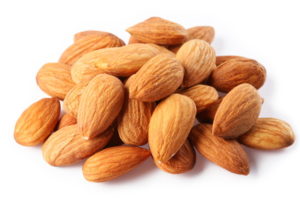

1 cup milk = 300mg ¼ cup almonds = 93mg ¾ cup plain 1-2% yogurt = 332mg
Low calcium levels are rare, as we have the ability to self-regulate our circulating calcium level. Low calcium status results in an increase in absorption. Dietary absorption of calcium declines if need is low. The body has a hard time absorbing a large amount of calcium at once, therefore, spreading out the intake of calcium, over all meals and snacks, is recommended.
What assists the absorption of calcium? 
- Vitamin D! Vitamin D is essential in helping the body absorb and use calcium. Along with vitamin D, vitamins C, E, K, and magnesium assist in absorbing calcium. Exercise also helps the body absorb calcium. Food sources of vitamin D include fatty fish, eggs, and fortified milk.
What impairs the absorption of calcium?
- Caffeine, stress, smoking, lack of exercise, alcohol, excess protein, and sodium can all impair our ability to absorb calcium.
Supplements?
More isn’t always better; the recommended daily recommended level of calcium should not be exceeded. If you have questions about your calcium intake and whether or not you need a calcium supplement, talk to a registered dietitian.
Read more at: http://www.eatrightontario.ca/en/Articles/Vitamins-and-Minerals/What-you-need-to-know-about-calcium.aspx
The post Calcium appeared first on Andrea Miller MHSc, RD Consulting Dietitian.
]]>The post All About Protein appeared first on Andrea Miller MHSc, RD Consulting Dietitian.
]]>Reviewed by Andrea Miller MHSc, RD
Protein is an essential nutrient that performs a variety of important functions in the body. This includes cell growth and repair, forming the structural component of tissues, producing hormones, building enzymes, maintaining fluid and electrolyte balance as well as pH balance, producing antibodies to protect against disease and use as an energy source. Protein can also act as building materials for bones, ligaments, tendons, muscles and organs.
Protein is abundant in the Canadian diet. Meat and dairy products including beef, poultry, fish, eggs, tofu, milk, cheese and yogurt all contain high levels of protein. A significant amount of dietary protein also comes from cereals, grains, nuts and legumes. It is important to incorporate both plant and animal based proteins into the diet. When choosing protein sources try to include lean meats, two servings of fish per week, and meat alternatives like dried beans, lentils and tofu. Protein rich foods provide many essential vitamins and minerals including iron, zinc and magnesium.
Dietary recommendations state that protein should contribute 10-35% of the total daily caloric intake. The amount of protein an individual needs can vary based on weight, activity level, presence of disease or illness, age and sex. Vegetarians need to pay extra attention to food choices, to ensure they are consuming adequate plant-based proteins. Protein needs can generally be met by consuming a variety of foods from all food groups. Most individuals can meet protein needs through diet and do not require protein supplements.
So what’s all this talk about protein shakes, powders, bars and supplements you ask?
Protein supplements have been found to be popular among athletes and people who want to gain muscle mass. However, research shows that most people, even athletes, can meet protein requirements without the use of protein supplements or powders. Protein supplements can be costly and have little benefit over a balanced diet. Additionally, many protein powders and bars are high in sugar, and saturated fat. Protein needs can be met by choosing a variety of protein-rich foods from all food groups.
Aim to divide your intake of protein-rich foods, over three meals and two to three snacks, daily. Our use of protein is more efficient when it is spread out over all meals and snacks. Keep portions to three ounces with meals and one to two ounces with snacks. Use these handy resources to measure your portions.
The bottom line: choose a variety of lean sources of protein, spread out over the day. Balance protein rich foods with whole grains, fruits and vegetables, milk products and small portions of fat. For more information regarding protein click here.
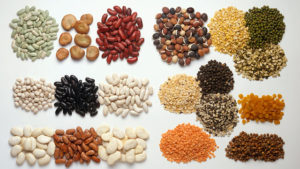
The post All About Protein appeared first on Andrea Miller MHSc, RD Consulting Dietitian.
]]>The post The Truth About Gluten appeared first on Andrea Miller MHSc, RD Consulting Dietitian.
]]>Reviewed by Andrea Miller MHSc, RD
“Going gluten free” appears to be a diet trend that has grown in popularity over the past several years. Grocery stores devote entire aisles to gluten free foods and celebrities and fitness enthusiasts promote its’ “health benefits.” Health claims that are associated with a gluten-free diet include weight loss, a reduction in bloating, improving skin tone, increasing alertness, and many others. Is a gluten free diet as beneficial as it is made out to be? What exactly is a gluten-free diet?
Gluten is a type of protein that is found in grains, including wheat, barley and rye. Gluten functions to give these foods shape and elasticity. Gluten is composed of two different proteins: gliadin and glutenin. It can be found in breads, soups, pasta, cereals, sauces, baked foods, some oats (if the are not certified gluten free) and even salad dressings.
Current research suggests that there is no evidence that gluten is bad or unhealthy for the general population. The benefits of a gluten-free diet are only be seen in individuals who have a gluten intolerance or celiac disease. These individuals produce an abnormal immune response when breaking down gluten during digestion. This immune response can damage intestines, which prevents the absorption of many essential nutrients. Symptoms associated with this response include bloating, cramping, diarrhea, skin rashes, and anemia.
In recent years, many people without a gluten intolerance or celiac disease are following a gluten free diet, as it has become a popular ‘trend’. One of the important and of unrealized challenges with a gluten free diet is that when gluten is removed from the diet, many other nutrients are also lost, as a result of removing a wide range of food choices. Nutrients that can become depleted, if not replaced by an alternate food source include, B vitamins, iron and fibre. Although gluten itself does not offer nutritional benefits, the whole grains that contain gluten, do. They are full of vitamins, minerals, antioxidants and fiber. Many gluten-free alternatives are processed foods that are low in fiber and protein and high in sugar and sodium.
All things considered, a gluten-free diet may actually cause more harm than good for those without celiac disease or any other medically prescribed reason for eliminating gluten from the diet. It is important to consult a Registered Dietitian for personalized nutrition advice and information.
For more information about celiac disease and a gluten free diet, check out the Canadian Celiac Association or this resource.
The post The Truth About Gluten appeared first on Andrea Miller MHSc, RD Consulting Dietitian.
]]>The post What Are Antioxidants and Why Are They Important? appeared first on Andrea Miller MHSc, RD Consulting Dietitian.
]]>Reviewed by Andrea Miller MHSc, RD
Antioxidants: The superheroes in our body! Antioxidants include Vitamins A, C and E, plant chemicals like flavonoids and minerals such as selenium. Antioxidants act to protect many of the cells in the body and to ensure they are working properly. Cell damage occurs naturally with increasing age and with exposure to pollution or cigarette smoke. Cell damage can lead to chronic diseases such as heart disease and diabetes. A diet rich in antioxidant nutrients can help lower the risk of these diseases.
Antioxidants are naturally found in fruits, vegetables, beans, lentils, nuts, seeds, garlic, green tea, vegetable oils and whole grains. Eating a variety of these healthy foods can help ensure you are getting amounts of these protective nutrients. Choosing whole foods over nutrient supplements is always the preferred method of meeting nutrient requirements. Antioxidants supplements often contain higher amounts of nutrients, than recommended. The amount of antioxidants found naturally in foods is safe and in the presence of a healthy, well-balanced diet, can provide health benefits.
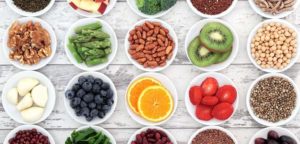
Here are some tips on how you can include more antioxidants in your diet:
- Enjoy a variety of colourful fruits and vegetables each day. Eat at least one dark green and one orange vegetable every day.
- Ensure at least one half of your servings of grain products are whole grains.
- Include nuts and seeds, peas, and lentils often- at least a few times/week.
- Choose fish at least twice a week. Salmon, halibut, tuna, mackerel and herring are excellent sources of vitamin E!
- Add berries to yogurt, smoothies or mix them into a fruit salad.
- Choose green tea instead of coffee. Green tea is a source of flavonoids.
- Try a mixed bean salad as a side with lunch or dinner.
- Canada’s Food Guide recommends 2-3 tablespoons of unsaturated fat each day (canola, olive, and soybean oils). Try to use small amounts of vegetable oil when preparing meals. Vegetable oils are a source of antioxidants!
- Sprinkle almonds and sunflower seeds on salads for a source of vitamin E.
- Eat a variety of antioxidant rich foods each day!
Read more at: http://www.eatrightontario.ca/en/articles/antioxidants/what-you-need-to-know-about-antioxidants.aspx#.V2AUbSMrJ1M
The post What Are Antioxidants and Why Are They Important? appeared first on Andrea Miller MHSc, RD Consulting Dietitian.
]]>The post Everything You Need to Know About Vitamin D appeared first on Andrea Miller MHSc, RD Consulting Dietitian.
]]>Reviewed by Andrea Miller MHSc, RD
May 9, 2016
Vitamin D is a fat-soluble vitamin that plays a very important role in our body. It is sometimes referred to as the “sunshine” vitamin, as our body is able to make the vitamin when exposed to the sun. It is necessary for bone, teeth, muscle and immune health. Vitamin D increases the absorption of calcium, which allows for proper bone and teeth development. It also lowers the risk of infection by helping immune cells to function properly. Vitamin D plays an essential role in muscle and nerve function. Recently, Vitamin D has been found to lower the risk of diseases and some cancers.
Our primary source of vitamin D is sunlight. It is also found in small amounts in foods such as salmon and eggs. Some food are fortified with vitamin D, including milk, orange juice and soy beverages.
The amount of vitamin D that you need depends on your age. For people aged 9-70 years old, the recommendation is 600 IU per day. To put this into perspective, 1 cup of milk contains 105 IU and a piece of salmon can range from 530-700 IU, depending on the size. Health Canada recommends a 400 IU vitamin D supplement for all adults over the age of 50 years.
Low levels of vitamin D can cause an increase risk of infection, especially among those who are critically ill or are prone to infection. Low levels can also lead to poor calcium and phosphorus absorption, resulting in weak bones and teeth, increasing the risk of osteoporosis. The upper intake level for vitamin D is 4000 IU per day. Total daily vitamin D intake should remain below this maximum amount allowed per day to avoid any possible negative side effects.
For more information click here and here.
The post Everything You Need to Know About Vitamin D appeared first on Andrea Miller MHSc, RD Consulting Dietitian.
]]>The post Fat: The Good, the Bad and the Ugly! appeared first on Andrea Miller MHSc, RD Consulting Dietitian.
]]>Reviewed by Andrea Miller MHSc, RD
Why You Don’t Need to be Fat-Free
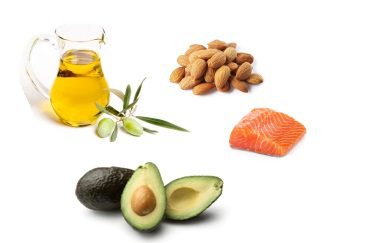 There seems to be a lot of misconception that fat isn’t good for you. Fat has been getting a bad rep since about the 1980’s, when we heard that eating fat would basically, well, make you fat. But whether you’re trying to lose weight, or just simply trying to eat a little healthier, the answer isn’t to cut out all fat, but to just choose wisely.
There seems to be a lot of misconception that fat isn’t good for you. Fat has been getting a bad rep since about the 1980’s, when we heard that eating fat would basically, well, make you fat. But whether you’re trying to lose weight, or just simply trying to eat a little healthier, the answer isn’t to cut out all fat, but to just choose wisely.
Although it might be hard to believe, fat is actually good for you. Our body uses fat to store energy, insulate tissues and organs, as well as absorb and transport fat-soluble vitamins. Some fats – the good ones – can actually help to increase your HDL (your good cholesterol) and therefore reduce your risk of heart disease.
Good Fat vs. Bad Fat
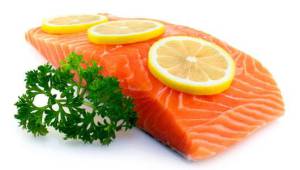 Good Fats: These are called monounsaturated and polyunsaturated fats, and they can help to lower your bad cholesterol and increase your good cholesterol, which may improve your heart-health.
Good Fats: These are called monounsaturated and polyunsaturated fats, and they can help to lower your bad cholesterol and increase your good cholesterol, which may improve your heart-health.
Bad Fats: These are the saturated fats and – the worst one – the trans fats. Research recommends that you consume as little of these fats, as possible, as they can increase risk for health problems.
Should I Be Buying Fat-Free?
The answer is – it depends. Fat-Free or Low-Fat doesn’t necessarily mean healthier, and there’s a good chance that the fat has been replaced with refined sugars or carbohydrates. This is why reading nutrition labels is important
How to Reduce the Bad Fat
- Check Nutrition Labels: Next time your are grocery shopping, check the fat content of the products you’re buying. Try to choose foods with no trans fats, and little or no saturated fats.
- Look for “Hydrogenated” in the Ingredients: This word means that the fat has been hardened, indicating that it has saturated or trans fat in it. If you’re buying margarine, choose those that are non-hydrogenated.
- Stick to Liquid, Buy Less Solid: Monounsaturated and polyunsaturated fats are liquid at room temperature, while saturated and trans fats are solid at room temperature. Try to buy more liquid vegetable oils and less butter or shortening.
- Choose Less Red Meat and Full-Fat Milk Products: These foods contain naturally occurring trans fats, and while they’re important in a balanced diet, try to replace them with other protein sources (try beans or fish) and chooser lower-fat milk products, such as skim milk, or low fat yogurt or cheese).
How to Get More Good Fat
- Make Your Own Dressings: Store-bought salad dressings are often high in saturated fats. Try making your own healthy fat dressing using olive oil or canola oil.
- Snack on Nuts: Nuts are high in monounsaturated fats, and make for a great snack to nibble on while making sure you’re getting your healthy fat intake for the day.
- Use Olive and Canola Oil: For your cooking use olive oil, and for baking use canola oil.
- Eat More Fish: Fatty fish like tuna, salmon, mackerel, or sardines are high in omega-3 fats, which are essential for heart health.
What Foods Have What Fats?
| Monounsaturated | Polyunsaturated | Saturated | Trans |
| Olive oil | Soybean oil | High-Fat Meat (beef, lamb, pork) | Commercially-Baked Goods |
| Canola oil | Corn oil | Chicken with the Skin | Fried Foods |
| Sunflower oil | Safflower oil | Whole Fat Dairy | Stick Margarine |
| Peanut oil | Walnuts | Butter | Vegetable Shortening |
| Sesame oil | Flaxseed | Cheese | Candy Bars |
| Avocados | Sunflower, Sesame, Pumpkin Seeds | Ice Cream | Packaged Snack Foods (popcorn, chips) |
| Olives | Fatty Fish | Palm oil | |
| Nuts | Soymilk | Coconut oil | |
| Peanut Butter | Tofu | Lard |
Read More At: http://www.helpguide.org/articles/healthy-eating/choosing-healthy-fats.htm
The post Fat: The Good, the Bad and the Ugly! appeared first on Andrea Miller MHSc, RD Consulting Dietitian.
]]>The post Whole Wheat vs. Whole Grain appeared first on Andrea Miller MHSc, RD Consulting Dietitian.
]]>Reviewed by Andrea Miller MHSc, RD
Whole Grain or Whole Wheat?
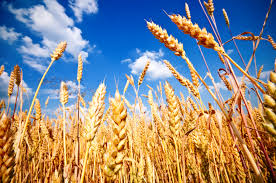 Grain products, one of the four food groups, are foods that are made or derived from barley, cornmeal, oats, rice, wheat, or any other cereal grain. Grains are often the seeds of certain plants. The bran, the endosperm and the germ are the three main parts of the seed, or kernel. All three parts contain valuable nutrients that play an important role in the diet.
Grain products, one of the four food groups, are foods that are made or derived from barley, cornmeal, oats, rice, wheat, or any other cereal grain. Grains are often the seeds of certain plants. The bran, the endosperm and the germ are the three main parts of the seed, or kernel. All three parts contain valuable nutrients that play an important role in the diet.
Grains are divided into two subgroups, whole grains and refined grains. Whole grains are grains that have undergone the least amount of processing and contain all three parts of the kernel. Refined grains are whole grains that have had the germ and bran removed. As a result, there is a loss of fiber, B vitamins, iron and other vitamins and minerals. Whole wheat is usually a refined grain, therefore, missing several important nutrients.
What to Look For
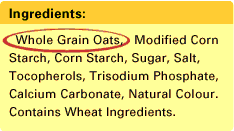 When looking for products that contain whole grains, look for the words “whole grain” on the label and in the ingredient list. Most foods containing whole grains will have the words “whole grain” followed by the name of the grain as one of the first ingredients. Rolled oats and brown rice are examples of whole grains, whereas white rice, white flour and cream of wheat are refined grains. Most refined grains are enriched. This means that certain B vitamins and iron that were originally lost when the germ and bran were removed are then added back after processing. However, fiber is not added back to enriched grains. When checking the ingredient list on refined grain products, make sure the word “enriched” is included in the grain name.
When looking for products that contain whole grains, look for the words “whole grain” on the label and in the ingredient list. Most foods containing whole grains will have the words “whole grain” followed by the name of the grain as one of the first ingredients. Rolled oats and brown rice are examples of whole grains, whereas white rice, white flour and cream of wheat are refined grains. Most refined grains are enriched. This means that certain B vitamins and iron that were originally lost when the germ and bran were removed are then added back after processing. However, fiber is not added back to enriched grains. When checking the ingredient list on refined grain products, make sure the word “enriched” is included in the grain name.
Why Choose Whole Grains?
Eating whole grains provides many health benefits, such as reducing the risk of some chronic diseases. Further, grains provide many nutrients, like B vitamins, fiber, iron, folate and several others that are vital for the health and maintenance of our bodies. Whole grains are a major source of dietary fiber that may help reduce blood cholesterol levels and may lower risk of heart disease, obesity, and type 2 diabetes. Fiber is also important in helping us feel full and for proper bowel function. Health Canada recognizes the importance whole grains play in a healthy diet and recommends that all Canadians should aim to get at least half of their grain servings as whole grains. It is with no doubt that whole grains should be included as part of a healthy diet.
Read more at:
https://www.eatrightontario.ca/en/Articles/Cooking-Food-Preparation/Cooking-with-Whole-Grains.aspx
The post Whole Wheat vs. Whole Grain appeared first on Andrea Miller MHSc, RD Consulting Dietitian.
]]>